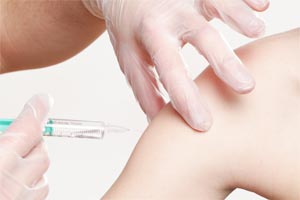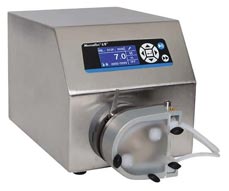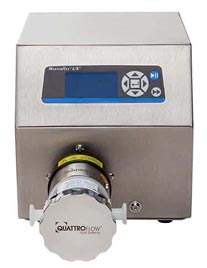The Important Role of Pumps in Vaccine Development and Production
 Humans face a myriad of pathogenic threats, from the common and seasonal flu to more aggressive disease-causing agents that lead to conditions like polio, measles, and more recently COVID-19. The agents that lead to these conditions are typically viruses or bacterial cells, and – depending upon their mode of attack – it can be difficult for the human body to respond quickly enough and effectively enough to prevent disease.
Humans face a myriad of pathogenic threats, from the common and seasonal flu to more aggressive disease-causing agents that lead to conditions like polio, measles, and more recently COVID-19. The agents that lead to these conditions are typically viruses or bacterial cells, and – depending upon their mode of attack – it can be difficult for the human body to respond quickly enough and effectively enough to prevent disease.
To help prepare and boost the effectiveness of the immune system’s response to these pathogens, a common preemptive step taken is the administration of vaccines. Vaccines come in a variety of forms, and each form is intended to stimulate the human body’s immune response to the presence of the pathogenic agents while ensuring the health of the host is not put at risk during the vaccination process. It is this desired and necessary outcome that leads to vaccine development cycles of several months to even several years. With such long development cycles, it is vital that careful attention is given to the hardware used along the entire fluid pathway at each developmental stage, to ensure vaccine batches remain viable and provide a high yield while minimizing the risk of contamination.
The Typical Stages of Vaccine Development
Vaccine development typically starts with identifying the actual pathogenic threat. Once the disease-causing agent is identified, research can begin to determine the most effective form a vaccine should take, including the following:
- Live-attenuated vaccines are comprised of weakened versions of the actual pathogen. Because of the similarity of the attenuated version of the pathogen to the actual pathogen, live-attenuated vaccines are typically very effective at stimulating a lasting immune response. They do carry risk, however, especially to those recipients who might have underlying health issues that would hinder a healthy immune response.
- Inactivated vaccines are typically comprised of fully inactive disease-causing agents. While being safer to a wider recipient base, they are also typically less effective at stimulating a lasting immune response and thus often require boosters to ensure the recipients’ immune system response is fully prepared to respond to the presence of live pathogenic agents.
- Subunit, recombinant, polysaccharide, and conjugate vaccines are developed using specific fragments of the disease-causing agents. These fragments are usually associated with areas or features of the pathogen that trigger the natural immune response of the host. Because of the nature of these vaccines, they are generally both very safe for the recipient as well as highly effective at priming the host immune system to respond aggressively when it senses the presence of those fragments.
- Toxoid vaccines are built around the inactivated versions of the toxins released by the disease-causing agents once they come into contact with the human body. They work to prepare the human immune system to more quickly identify the presence of the toxins and then focus the immune response in the area the toxin is found. These types of vaccines can sometimes have only limited effectiveness and therefore require boosters to maintain the necessary level of effectiveness required for adequate immune response.
Once the proper type of vaccine has been identified, the vaccine must enter a rigorous and complex manufacturing cycle. The steps of this cycle can generally be described as follows:
- Cultivation – During this stage, the seed batch of pathogens is cultivated and grown to produce much larger batches of the pathogen. In this stage, things like temperature, pH, nutrient balance, etc., all must be considered, monitored, and controlled.
- Clarification / Purification – Once the target quantity of the disease-causing agent has been successfully produced, the batch runs through a process that removes all traces of the supporting media. This ensures the purified agent is ready for the next stage of development and ultimately for packaging and distribution.
- Preparation for Filling / Packaging – During this stage, any necessary steps (e.g. inactivation) are taken to the batch contents to prepare it for the final stages of production and to ensure host safety.
- Filling / Packaging – In this stage, the vaccine is most often filled into syringes and vials for end-user consumption. Steps are taken to ensure the finished product is stable and viable, while careful attention is given to ensure the safety of the hosts.
Transferring Vaccine Contents Throughout the Production Cycle
Each stage of the production cycle requires careful transfer of the batch fluid. Because of the nature of most vaccines – wherein they often contain either active or inactive pathogens – and because it is the presence of these disease-causing agents that allows the vaccines to be effective, it is vital that the equipment and hardware used throughout the fluid pathway is designed to maintain pathogen viability.

With the typical vaccines being sensitive to the level of shear forces to which they are exposed, pump technologies such as our Heads can be very effective pump options. The drives offer stainless steel cases for easy cleaning, and the Cytoflow pump heads are peristaltic pump heads that feature a unique convex roller and concave tube bed design that reduces shear and has been shown in independent studies to improve overall yield while minimizing damage to the cellular or viral contents of the vaccine. When these pump drives and heads are coupled with tubing that both carries the necessary regulatory ratings and that offers the needed lifetime for each stage of vaccine development, high yields of finished product can be realized.
In applications where higher pressures might be present – such as during a tangential flow filtration (TFF) step of the purification process – the recommended pumping system would involve coupling the Masterflex L/S Process Pump drive previously highlighted with the innovative Quattroflow™ pump head. This unique four-chambered diaphragm pump head supports elevated pressures while maintaining the low-shear characteristics needed to ensure a high yield of viable vaccine material with each batch processed.

For those applications where only pathogen fragments are used and where maintaining viral or bacterial integrity is not as important, utilizing a Masterflex L/S or I/P Stainless Steel Process Drive coupled with a more traditional Easy-Load® II Pump Head may be worth considering. This well-accepted drive and head option offers reliable peristaltic pump performance at a more affordable price when compared with the Cytoflow or Quattroflow options previously highlighted. And because of its inherent easy-to-use design, it is often the first choice of many customers around the world.
Advantageously, both the traditional peristaltic pump solutions using the Cytoflow pump head and the Easy-Load II pump head, as well as the higher-pressure Quattroflow pump head option, lend themselves well to single-use applications, resulting in minimal downtime and increased cost savings.
Leveraging Pump Technologies for Real Benefits in Vaccine Development
As discussed, vaccine development is a time-intensive and complex process; one that needs to result in high yields with minimal contamination and downtime. By choosing a Masterflex pump system that is ideally tailored for these demanding applications, those involved in vaccine development can realize cost savings as well as leverage inherent ease-of-use features that many in the industry appreciate. When coupled with the available wide selection of Masterflex tubing, there is sure to be a Masterflex solution for virtually every fluid transfer or dispense need during the vaccine development cycle.
Vaccine image credit: Angelo Esslinger at Pixabay
 Media Prep
Media Prep